There is no better way to stand out from the crowd in a job interview, business meeting, or formal event than wearing a perfectly tailored suit! But finding the right suit size for your body can prove challenging. Fortunately, you can learn how to measure for a suit by following a few simple steps to get your suit jacket and suit pants size.
Finding the right suit size and fit depends on an accurate suit jacket and suit pants measurements. Jacket sizing requires measuring the width of the chest, the length of the shoulders and arms, the neck, and the wrist. To get accurate suit pants measurements, measure the waist, hips, thigh, inseam, and outseam.
In this article, you will learn how suit sizes work. You will find out how to take your own measurements for both a suit jacket and pants. Finally, you will discover tips for how to get the right suit fit for your body.

Quick Navigation
How Do You Determine Your Suit Size?
The key to determining your suit size is taking good measurements and understanding how to use those measurements accurately.
You may wonder why you can’t just use your “normal” clothing sizes when looking for a suit. Actually, there are a couple of reasons for this!
First, most suits do not come in the standard American small, medium, and large sizing system. Instead, they use a special system for jacket sizes and a special system for pants sizes.
It works like this: A jacket size will list an even number and then a letter. The number, such as 34 or 38, indicates chest size. The second part of the size code tells you the length of the jacket and comes as a letter, usually S, R, or L. S means a short length, R means regular length, and L means long.
Then you have the pants size. Men’s pants like jeans, often have a size that lists the waist X the inseam. Some suit pants do this as well, but you often find just the waist size listed because many suit pants come unhemmed. This is because historically, men bought suits partially finished and took them to a tailor to get them fitted.
(Don’t worry–if you plan to buy your suit online or from Men’s Wearhouse, you can get pants with a hem! Many modern companies provide the inseam length to help you with this).
Second, formal clothing like suit jackets and pants use different kinds of fabric than your standard casual wear like jeans and t-shirts. Your waistband size in jeans is probably not the same as your waistband size in suit pants, for example, because jeans stretch when you wear them, and the fabric in suit pants will not!
The bottom line is that suits use a unique sizing system which means you do need to take your own measurements to get a good fit. Fortunately, you can learn how to do that in the next section!
How to Measure for a Suit
To measure for a suit, you’ll need to get accurate shoulder, chest, and neck lengths for your jacket. You will also need to find your waist, inseam, and outseam measurement to find your suit pants size.
How to Measure for a Suit Jacket
Suit jackets, sports coats, and blazers all have a fitted style which means getting accurate measurements makes a huge difference. Think of it this way: a suit jacket closely fits your entire torso, so it makes sense that you need to measure all of the key areas of your torso to get a good fit.
Shoulders
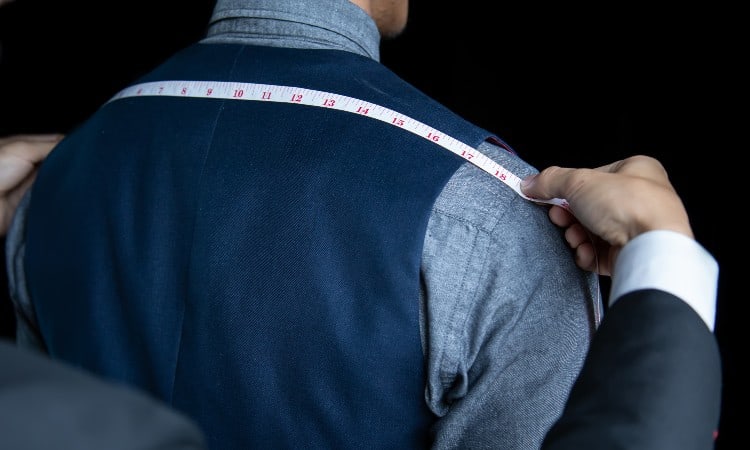
An accurate shoulder measurement will help you buy a suit jacket with shoulder seams that fall right at the ends of your shoulders in that classic, crisp line.
To measure shoulder width:
- Ask a friend to help. You really can’t take this measurement by yourself!
- Wear the dress shirt you want to wear with the suit jacket. This helps in getting the right measurement.
- Stand with your feet slightly apart and your shoulders in a relaxed, natural posture, with your hands hanging loose at your sides.
- Ask your friend to stretch a flexible tape measure across your back from the end of one shoulder to the other, curving with the shape of your upper back.
- The easiest way to locate these endpoints is to find the shoulder seams in the dress shirt. These should lie right over the ends of your shoulders.
- Plus, your friend can also follow the yoke seam along the upper back of the shirt for an even easier measurement!
- Write down the number and use this as your shoulder measurement.
Chest

Your chest measurement is a part of the size code offered on your suit jacket, so you can see how important it is!
To get the most accurate results, you want to use a two-part process.
First, measure the circumference of the broadest area of your chest:
- Wear the shirt and undershirt you plan to wear beneath the jacket.
- Stand with your feet slightly apart and flat on the floor. Position yourself with your back to a mirror.
- Next, use a flexible tape measure to circle the widest section of your chest. Pass the tape beneath your arms and use the mirror to make sure it remains parallel to the floor as it crosses your back.
- Let out your breath and heck the measurement once you have completed a full circle with the tape.
You can use this chest measurement as the number part of a jacket size. If you want a skinny fit, consider subtracting an inch from that number. For a more relaxed fit, add an inch to your measurement.
But for the best results, you should also do an overarm chest measurement.
- Start as you did before, wearing the same shirt and planting your feet.
- You still want to circle your torso at the widest portion of your chest, but this time, wrap the tape around the outside of your arms instead of going underneath them.
- Once again, make sure the tape stays level as it crosses your back.
- Let out your breath and note the measurement where the tape ends meet.
- Subtract seven inches from this measurement.
- Now compare the results of your overarm and underarm chest measurements. If the overarm measurement (minus 7) is bigger than the regular chest size, you should use the overarm number as your official jacket size.
- For example, suppose you took an overarm measurement of 50 inches. Subtract 7, and get 43. If your regular chest measurement gave you just 41 inches, you should use the 43” as your jacket size. This will give you a better fit for your broad shoulders.
Neck
Not all suit sizing charts provide a neck measurement, but it only takes a second and you may find it helpful for certain brands.
All you have to do is gently wrap a flexible tape around the base of your neck or just below your Adam’s apple. For a more comfortable fit, try placing one finger beneath the tape as you take the measurement.
Length
Of course, jacket length forms the second part of the jacket sizing code, so you can bet this measurement makes a big difference in a good fit! The basic measurement for suit jacket length is to find the distance between the base of your neck and your thumb.
To measure for suit jacket length:
- Ask a friend to help, as you need to stand with both hands hanging loosely at your sides to get an accurate measurement.
- Ask your friend to use a ruler and hold it at the base of your thumb. Using the ruler as a guide, mark this point on the front of your pants with a safety pin.
- Next, have your friend place one end of a flexible tape measure at the base of your neck, right where it meets your shoulder.
- Now drop the tape down your chest and to the safety pin in your pants.
- This distance, from the base of your neck to the point on your leg that correlates with the base of your thumb, is your jacket length!
Sleeves
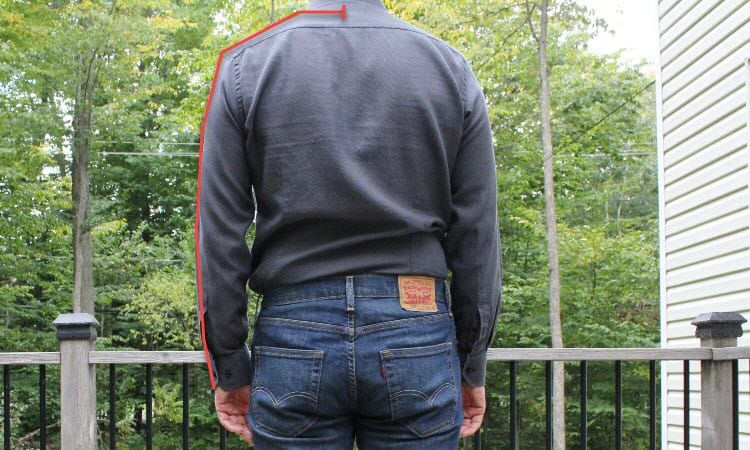
Sleeve length matters just as much as pants length, as it determines where the cuff of the jacket will fall on your hand or arm. Obviously, too-short sleeves will look tacky and leave your wrist hanging out in the air!
To take a sleeve measurement:
- Relax your shoulders into your regular posture.
- Place one end of a flexible tape measure at the end of your shoulder. To make this easier, wear a dress shirt that fits you perfectly, and locate the shoulder seam at the top of your shoulder. This can act as your starting point.
- Next, trace the tape down the length of your outer arm.
- Stop when you reach the base of your thumb. If you gently press the bottom of your thumb where it connects to your hand, you will feel a knobby bone at this point.
- Write down this measurement.
Wrist
In some cases, especially for a fitted or skinny-cut suit, you may also want to take a wrist measurement.
Just like your neck measurement, this is as simple as it sounds!
- Measure around the bony portion of your wrist. Keep the tape snug but not tight.
- As you write down the measurement, round up to the closest quarter inch.
- Add two inches to this total to get your final cuff measurement.
How Do You Measure Yourself for Suit Pants?
To get the best measurements for suit pants, you need your waist, hip, and thigh circumference. Often you also need the length of your inseam to know what size of pants to buy. In some cases, you may also need to take an outseam measurement to determine the trouser break of your pants.
Unlike jacket measuring methods, you want to take off your clothes for accurate pants measurements or wear close-fitting undergarments to avoid skewing your results.
Waist
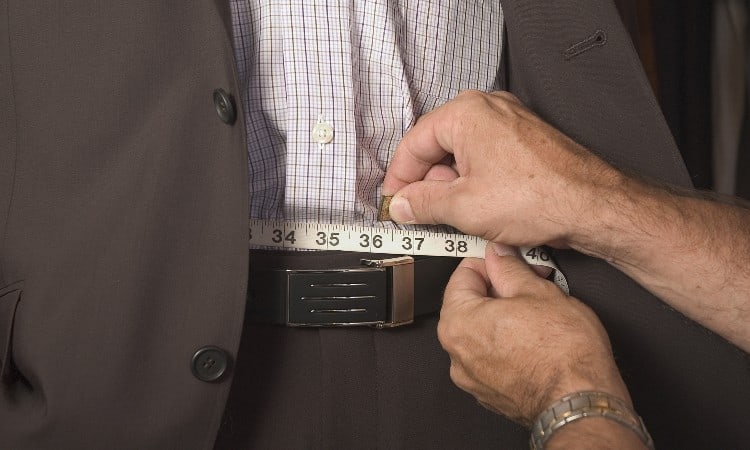
To get the best waist measurement for your pants, you want to find the spot where you would wear a belt. This matters because different styles of pants can place the waistline in many different places, ranging from above your navel to just above your hips!
- Start by standing with your feet slightly apart and flat on the floor.
- Pick the place where you want the waistline of your suit pants to go. For most modern style suit pants, this point will fall slightly above the curve of your hip bones but below your navel.
- Wrap a flexible tape measure around your torso at this point. Use a mirror to make sure you keep the tape level as it circles your body.
- Don’t suck in your stomach. Make sure you maintain a loose but straight posture to get the most accurate measurement.
Hips
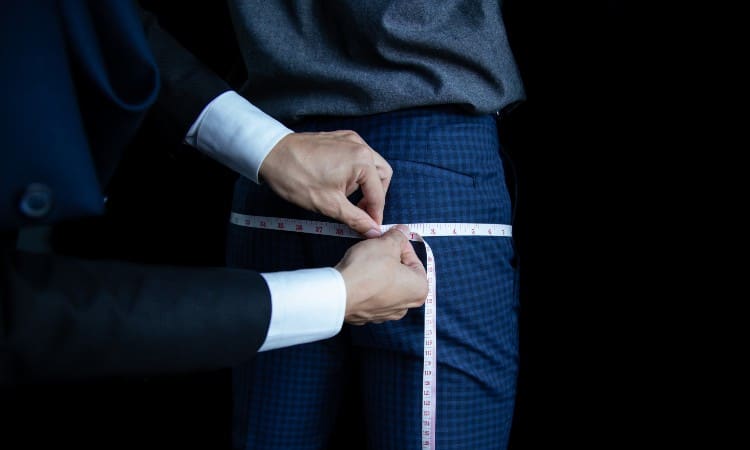
The hip or seat measurement will help you avoid the dreaded baggy elephant-leg look in your suit pants. While the waist measurement will show in the size code for the suit pants, the hip measurement may matter even more in terms of a good fit for you!
- Find a place to take this measurement with a mirror you can position behind you.
- Stand with your feet slightly apart and flat on the floor. Find a good relaxed posture with a straight back and loose arms.
- Now locate the rounded tops of your hip bones.
- Use the top of one hip bone as your start point. Then wrap the flexible tape measure around the widest area of your seat. Check in the mirror to make sure you keep the tape level.
- Circle all the way back around across the top of the other hip bone and to your starting point.
Thigh
Not every brand will offer a thigh measurement in a sizing chart, but in some cases, you may find it helpful to find suit pants that comfortably fit your legs. You will want this measurement if you have heavily muscled legs or want a skinny-fit suit.
- Find a point one inch down from the crotch seam on your inner thigh.
- Keep the tape parallel to the floor as you wrap it around your upper leg at this point.
- Bring the tape back to your start point and write down the circumference of your thigh.
Inseam
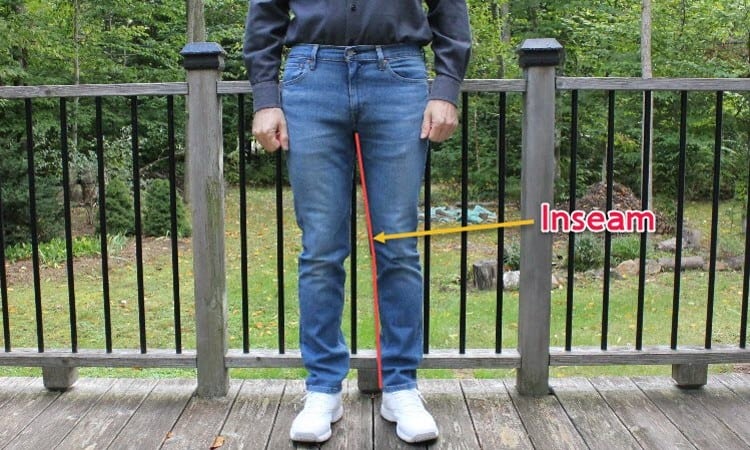
The inseam of your pants gives you the length used in the size. To get this measurement, you find the length of your inner leg from the top of your thigh to your ankle.
- Wear the dress shoes you want to pair with your suit as you take this measurement. Also, it’s a good idea to wear close-fitting biking shorts or some other snug garment to avoid accidentally bulking out the measurement because of baggy clothing.
- Stand with your feet slightly apart and place the end of the tape measure at the point where your inner thigh meets your crotch. You can also use the crotch seam as your starting point if you locate that on your shorts or pants.
- Trace the tape down your inner leg all the way to your ankle.
- Write down this measurement.
Outseam
An outseam measurement gives you the length of our outer leg, which helps you determine the break of your suit pants. Other pants, like jeans, do not call for an outseam measurement. But in suit pants, this measurement plays a key role in your final appearance!
What is a trouser break? It is the point where the hem of your suit pants touches the top of your dress shoe. Different styles look best with a full break that shows a distinct fold where the pants touch the shoe, or no break, where the bottom edge of the hem just barely brushes the top of the shoe.
- Ask a friend to help you take this measurement.
- In your socks, stand with your feet slightly apart on the floor.
- Have your friend place one end of the tape at the center back of the waistband in your pants.
- Your friend should pinch that end of the tape firmly into place and let the long tail of the tape fall to the floor in a straight line.
- Have your friend pin the tape to the floor to make sure it holds a straight line, and write down the number of that distance in inches.
- Now you can put away the tape and do a little math to figure out your trouser break. If you want a full break where the hem of your trouser gently folds over onto the top of your shoe, leave the measurement as it is. For no break, subtract two inches. For a half break, take away one inch.
Suit Measurements Explained
Now that you know how to take your own measurements for a suit jacket and suit pants let’s take a look at how you can best use those measurements to get your perfect suit.
You need to know three key things to understand suit measurements.
First, you should compare your measurements to the sizing chart provided by the brand or company you like. Most brands will post these charts online. Unfortunately, you can’t just find your suit size one time and never use your measurements again because of the second thing you need to know about suit sizes.
The second key thing to remember is that clothing brands have no universal sizing guidelines. This means that you could find a 34L suit jacket that you love in one brand and then discover that 34L in another brand does not fit you at all!
Finally, besides coming in different sizes, suits also come in various fits. You can read more about this later in this article in the section titled “How Should a Suit Fit,” but for now, keep in mind that different cuts of suits will fit you more or less tightly. You can think of this as similar in concept to the way skinny jeans and dad jeans fit your body in a very different way!
Suit Measurements Template
While it’s true that the exact measurements used do vary from one brand to another, this suit measurement template will give you a general idea of what you can expect in suit sizes.
Keep in mind that some brands offer more sizing metrics than others. Generally, more expensive brands will offer more options such as neck, wrist, and so on. Ready-wear brands you find on Amazon will offer fewer options as a way to cut costs.
This suit jacket size template gives you an idea of how typical measurements align.
| Size | Chest | Overarm | Neck | Shoulder | Sleeve | Length |
| 34R | 32”-34” | 40”-42” | 14.15” | 17.5” | 32” | 30” |
| 34S | 32”-34” | 40”-42” | 14.15” | 17.5” | 32” | 30.5” |
| 36R | 32”-36” | 42”-44” | 14.15” | 18.25” | 32” | 30.5” |
| 36S | 32”-36” | 42”-44” | 14.15” | 18.25” | 32” | 30” |
| 38R | 37”-39” | 45”-47” | 15” | 19” | 33” | 30.5” |
| 38S | 36”-38” | 44”-46” | 14.5” | 19” | 33” | 30.5” |
| 38L | 36”-38” | 45”-47” | 15” | 18.75” | 33” | 30.5” |
What Does 42R Mean in Suit Size?
A suit size of 42R means that the suit jacket has a chest size of 42” inches and comes in a regular length, typically around 31” for that size of the jacket.
Of course, the precise measurements may vary from one brand to another, so you should always compare your measurements to a sizing chart before selecting a suit coat size to buy.
Is Size 42 Large or Medium?
Generally speaking, suit sizes do not use the classic “small, medium, large metric,” but if you compare a size 42 suit to other types of clothing, it would have the same measurements as many clothes with large sizes.
You should always check the sizing chart for the suit you want to buy to make sure it fits you everywhere, not just in the 42” chest, though!
What Size is a 36 Regular Suit?
A 36 Regular suit would have a 36” chest measurement and fall somewhere around what you typically think of as “medium” sizing in other kinds of clothes.
You can expect the jacket to have roughly a 30 to 30.5” length and about 32” sleeves.
Where to Get Measured for a Suit for Free
You can get measured for a suit for free if you visit a department store or specialty tuxedo and suit store in person. Most places that focus on selling suits, such as Men’s Wearhouse and Nordstrom, will offer this service on the house as a way to encourage you to buy from their clothing lines.
You can also buy an off-the-rack suit and o to a professional tailor for some minor alterations. Tailors can take expert measurements for you in minutes and also take in, hem, or alter a suit to fit you perfectly!
How Do I Determine My Blazer Size?
To determine your blazer size, you need your chest measurement and your jacket length measurement. Some brands may also allow you to select sleeve length, but this varies from brand to brand.
Blazers typically follow all the fitting rules of a suit jacket. The difference is that you often wear a blazer by itself as a standalone piece in an outfit, while a suit always has a matching jacket and pants.
How Should a Suit Fit?
Your suit should fit you comfortably with the shoulder seam aligned over the end of your shoulder and the sleeve and pant hems at an appropriate length.
Key things to avoid in a suit are:
- Too-short sleeves or pant legs.
- Too-tight jackets with creases or gapes when you button them shut.
- Overly broad shoulders that hang down onto your arms.
Another thing to think about when selecting the right suit fit for you is that suits typically come in several different styles. Suppose you decide that you want a 34R suit jacket. You could get this jacket in the same size but featuring a classic cut, a slim fit, or a modern fit.
- A classic fit has a slightly roomier shape all over, characterized by a broader shoulder, extra room in the chest, and a relaxed fit in the thigh. The suit pants typically have a straight leg in a classic fit style. Some brands also call this the “regular” cut.
- A slim-fit suit has a more tailored, sharp outline that looks trendy. It comes with tightly fitted shoulders, a nipped-in waist, and slim-cut pant legs that taper below the knee. This style of suit does not provide as much ease of movement as a classic cut, but it does look more modern.
- A skinny or modern style of suit often has a more generous fit than a slim-fit suit but looks less old-fashioned and boxy than a classic suit. The key difference is that this cut offers larger armholes for ease of movement while maintaining tapered pant legs and a fitted waist.
Different brands may use their own terminology to define these styles. Make sure you read the product description of the suit you like to find out what kind of cut it has!
Conclusion
Learning how to measure yourself for a suit takes a little time, but it will help you find a suit jacket and pants that fit you perfectly! For a suit jacket, you will want to take chest, shoulder, neck, sleeve, and jacket length measurements to get the best fit. For suit pants, start with the waist and inseam measurements, and then add on thigh and outseam measurements if the brand you like offers those options.
Once you have your measurements, compare them to the sizing chart offered by most brands online to find your size! Suit jacket sizes typically come in the format of chest measurement followed by length, such as 34R. Suit pants offer the waist measurement as a metric, such as 32 or 34.